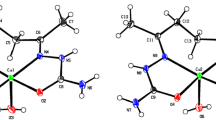Abstract
The crystal structures of three copper(II) complexes of pyridine-2,6-dithiocarbomethylamide (P DT A) were determined by X-ray crystallographic methods. The structure of the bromide CuP DT ABr2 · H2O (2) is isomorphous to the known crystal structure of the chloride CuP DT ACl2 · H2O (1). The iodide CuP DT AI2 ·D M F (3) is non-isomorphous to the other two halogenides, but shows a very similar square-pyramidal 5-coordination of the copper atom. In contrast to the halogenides, the crystal structure of the nitrate CuP DT A (H2O)2 · (NO3)2 (4) shows a square planar metal coordination by theP DT A ligand and one water molecule. If one includes the second water molecule and one oxygen atom of a nitrate ion, the metal coordination becomes distorted octahedral.
Zusammenfassung
Die Kristallstrukturen von drei Cu(II)-Komplexen des Pyridin-2,6-dithiocarbomethylamids (P DT A) wurden mit der Methode der Röntgenstrukturanalyse bestimmt. Die Struktur des Bromids CuP DT ABr2 · H2O (2) ist isomorph mit der bereits bekannten Kristallstruktur des Chlorids CuP DT ACl2 · H2O (1). Das Jodid CuP DT AI2 ·D M F (3) zeigt — bei nicht isomorpher Kristallstruktur — eine den beiden anderen Halogeniden sehr ähnliche quadratisch-pyramidale 5-Koordination des Cu(II). Demgegenüber beobachtet man in der Kristallstruktur des Nitrats CuP DT A(H2O)2 · (NO3)2 (4) eine quadratisch planare Metallkoordination durch denP DT A -Liganden und ein Wassermolekül. Zählt man das zweite Wassermolekül und ein Sauerstoffatom eines Nitrations der Metallkoordination zu, so erhält man eine stark verzerrt-oktaedrische Koordination.
Similar content being viewed by others
References
Kratky C., Jorde C., Popitsch A., Monatsh. Chem.113, 933 (1982).
Germain G., Main P., Woolfson M. M., Acta Cryst.A 27, 368 (1971).
Sheldrick G. M., SHELX 76, a program for crystal structure determination. University of Cambridge, England.
Stewart G. M., The XRAY system version of 1976. TR-466, CSS, University of Maryland, USA.
Motherwell S., Program PLUTO, University of Cambridge, England.
Hathaway B. J., Billing D. E., Coord. Chem. Rev.5, 143 (1970);Hathaway B. J., Hodgson P. G., J. Inorg. Nucl. Chem.35, 4071 (1973).
Popitsch A.,Czaputa R., Monatsh. Chem., in press.
Popitsch A., Gagliardi E., Schurz J., Kratky C., Monatsh. Chem.112, 537 (1981).
Kratky C., Schurz J., Gagliardi E., Popitsch A., Monatsh. Chem.112, 721 (1981).
Author information
Authors and Affiliations
Rights and permissions
About this article
Cite this article
Kratky, C., Jorde, C. & Popitsch, A. Crystal structures of Cu(II) complexes of pyridine-2,6-dithiocarbomethylamide. Monatsh Chem 114, 829–838 (1983). https://doi.org/10.1007/BF00799945
Received:
Accepted:
Issue Date:
DOI: https://doi.org/10.1007/BF00799945



